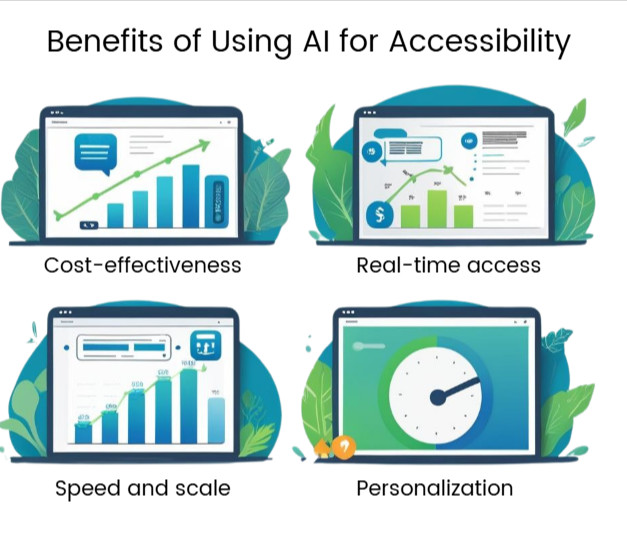What Is AI in the Context of Accessibility?
Artificial intelligence (AI) refers to computer systems designed to perform tasks that typically require human intelligence. These include understanding language, recognizing images, translating content, and making decisions. In accessibility, AI helps bridge gaps by automating or supporting processes that make digital environments more inclusive for people with disabilities.
When applied to accessibility, AI often leverages technologies like machine learning, natural language processing, and computer vision. These tools allow systems to analyze and interpret complex information, such as identifying visual content in images or transcribing spoken words into text. They can also adapt interfaces based on user preferences, detect accessibility barriers in real time, and support multilingual communication. By automating tasks that once required manual intervention, AI can enhance the efficiency and reach of accessibility efforts, especially across larger volumes of digital content.
It is crucial to remember that AI in accessibility is not meant to replace human insight. While it can enhance and accelerate certain tasks, human oversight ensures the contextual accuracy and empathy required for truly inclusive experiences.
Real-World Applications of AI in Accessibility
By offering faster and more scalable solutions across websites, documents, and online tools, AI is transforming the way digital tilgængelighed is achieved. Here are some common real-world uses of AI in accessibility:
Automated Image Recognition & Alt Text Generation
AI-powered systems can identify elements in an image and generate alternative (alt) text for screen reader users. Services like Microsoft Azure Cognitive Services and Facebook’s automatic alt text offer automatic tagging and descriptions of photos posted online.
This is useful for large-scale content where human-generated descriptions would be time-consuming. However, AI-generated alt text can lack nuance and may misinterpret the context of an image. Human review is crucial, especially for sensitive or complex content.
Speech-to-Text and Captioning
AI is widely used for live captioning and transcription. Tools such as YouTube’s auto-captioning and Google Meet’s speech recognition help deaf and hard-of-hearing users engage with real-time audio.
While speech-to-text AI offers a fast solution, it can struggle with accuracy from time-to-time when dealing with multiple speakers, accents, background noise, or specialized terminology. Despite continuous improvements to this technology, human-edited captions are more reliable for high-accuracy needs.
Text Simplification and Language Support
Supporting cognitive accessibility, AI systems can simplify complex language or translate content. For example, Microsoft Immersive Reader helps users with dyslexia or learning disabilities by rephrasing difficult text and adjusting visual presentation.
Additionally, AI-powered translation tools break down language barriers for non-native English speakers, making digital content more accessible to a wider audience. These features are vital for global education platforms, government services, and public information websites.
Accessibility Testing and Remediation Support
AI is also improving how digital content is tested and remediated for accessibility compliance. Automated tools scan websites and documents to identify issues such as missing alt text, incorrect heading structure, or low contrast.
GrackleDocs solutions, such as GracklePDF, use AI-assisted features to help users identify and correct accessibility issues in PDFs and other digital documents. While AI can speed up compliance efforts, it shouldn’t replace manual testing, especially for complex interactions or nuanced user experiences.
Benefits of Using AI for Accessibility
AI offers several advantages for making digital content more accessible:
Speed and scale: AI can scan and tag thousands of files or pages in minutes.
Cost-effectiveness: Organizations can reduce the burden of manual accessibility work, especially when dealing with large volumes of content.
Real-time access: Features such as live captions and translations help users interact with content as it’s delivered.
Personalization: AI can adapt digital interfaces to individual needs, such as adjusting reading levels, fonts, or color contrast.
These benefits collectively help organizations meet accessibility goals more efficiently, especially when combined with inclusive design strategies.

Limitations and Challenges of AI in Accessibility
Despite its promise, AI is not without its flaws. Some of the biggest challenges include:
Lack of context: AI can misinterpret the meaning of images, tone in speech, or text requiring detailed or cultural knowledge.
Over-reliance: Depending too heavily on automation can result in missed errors and inaccessible experiences.
Ethical concerns: AI used in surveillance or facial recognition can pose privacy risks, especially when misused for identifying disabilities.
It’s critical that organizations understand these challenges and protect against them by implementing human review processes and ensuring all AI-driven tools align with recognized accessibility standards like WCAG og PDF/UA.
Responsible Use of AI in Accessibility
Ethical and effective use of AI in accessibility depends on incorporating human oversight at every stage. Human-in-the-loop models ensure that AI-generated outputs are reviewed for accuracy and real-world applicability. This step is essential, especially when dealing with sensitive content or nuanced communication that AI may struggle to interpret correctly.
AI tools should be developed and deployed in alignment with global accessibility standards such as WCAG og PDF/UA. By supporting these frameworks, organizations can ensure that their use of AI contributes to compliance and fosters truly inclusive digital environments.
Transparency is also critical. Developers should regularly audit their AI systems to detect and correct discriminatory or misleading outputs. This includes scrutinizing the training data and algorithms to avoid reinforcing harmful stereotypes or excluding specific user groups.
Inclusive design practices must be a core part of the development process. This means involving people with disabilities in testing, providing feedback, and shaping how the AI behaves based on real-world scenarios.
Together, these practices help ensure that AI enhances rather than hinders accessibility. They reinforce the principle that AI should be a tool for inclusion, guided by standards, ethics, and the lived experiences of those it aims to support.
The Future of AI and Inclusive Technology
The next generation of AI promises powerful innovations that will further advance digital accessibility. One major development is the use of AI avatars for sign language interpretation. These avatars will help deaf and hard-of-hearing users engage more effectively with digital spaces, offering real-time translation across websites, video conferencing, and customer support platforms.
AI is also paving the way for personalized digital assistants that recognize and adapt to individual accessibility preferences. These assistants are designed to automatically adjust content presentation, such as font size, color contrast, or layout; suiting the unique needs of each user.
Another transformative advancement lies in the automatic generation of accessible documents. AI can convert templates or scanned materials into formats that meet relevant Tilgængelighedsstandarder. This not only speeds up the remediation process but also enables organizations to maintain compliance across large volumes of content with greater accuracy.
As AI continues to integrate into education platforms, government services, and workplace systems, it will offer real-time, tailored support for people with a variety of access needs. However, the success of these technologies will depend on strong partnerships between AI developers, accessibility professionals, and the disability community. Collaboration will be key to ensuring these tools are both inclusive and genuinely useful in real-world contexts.
AI as a Partner in Digital Inclusion
AI is reshaping the way we approach digital accessibility, but it is not a complete, standalone solution. It works best when used in partnership with human insight, universal design principles, and regulatory compliance.
While AI can enhance accessibility by simplifying processes and improving scalability, it must be used by organizations as a supportive tool. True accessibility is achieved through user-centered thinking and a dedication to continuous inclusivity improvements.
At GrackleDocs, we are committed to leveraging AI as part of our mission to make digital content accessible for all. By combining smart technology with inclusive values, we help organizations move closer to a truly equitable digital world.
